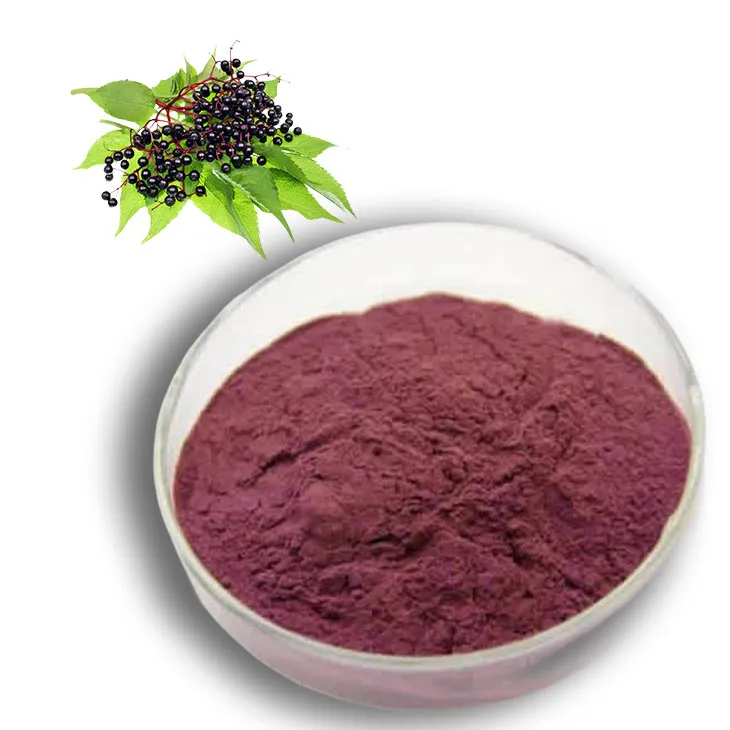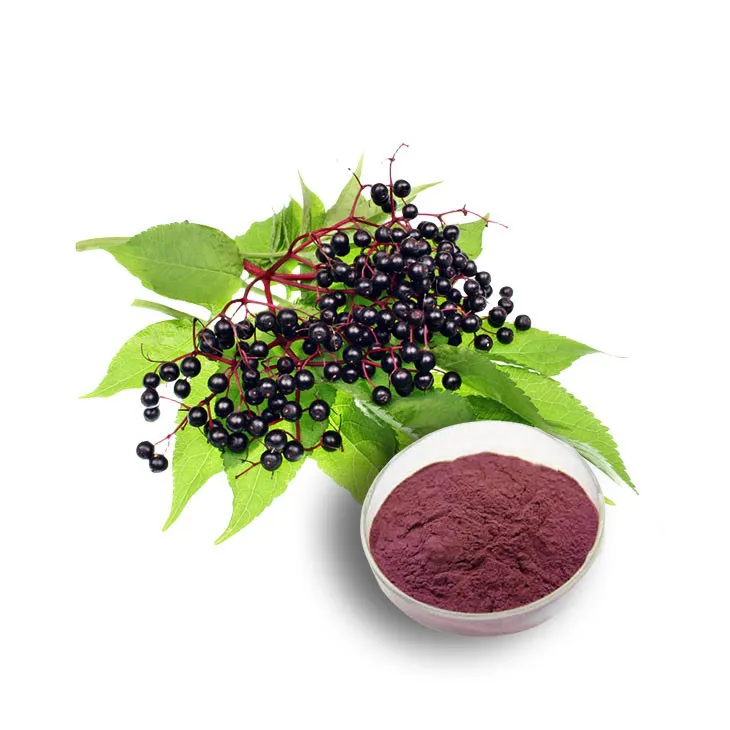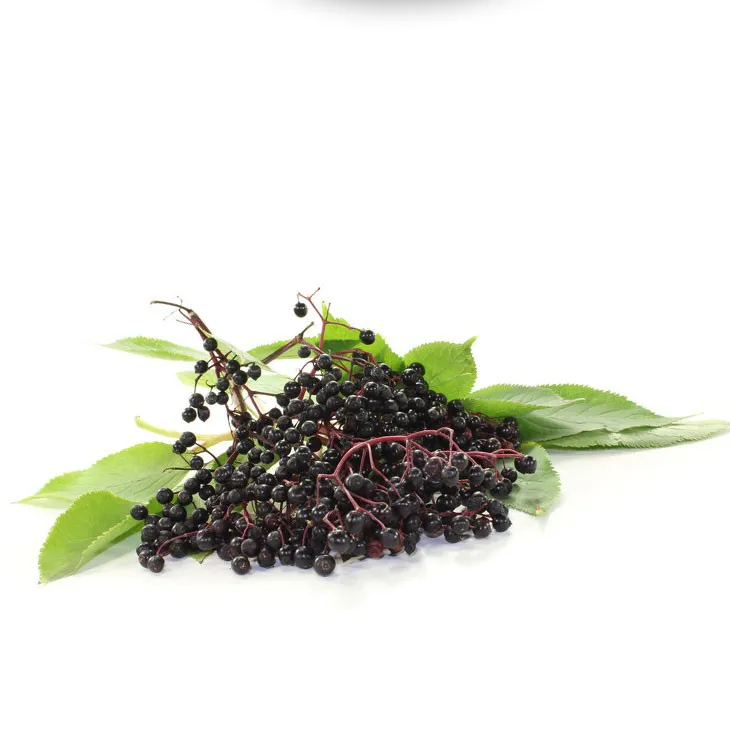- 0086-571-85302990
- sales@greenskybio.com
Extraction process of elderberry extract.
2024-11-26

1. Introduction
Elderberry Extract has gained significant attention in recent years due to its potential health benefits. The extraction process is crucial in obtaining a high - quality product with the desired bioactive compounds. This article will explore in detail the various steps involved in the extraction of Elderberry Extract, from the initial selection of berries to the final purification steps.

2. Selection of Elderberries
The first step in the extraction process is the careful selection of elderberries. Ripe elderberries are preferred as they contain a higher concentration of the desired compounds.
2.1. Criteria for Selection
- Color: Ripe elderberries typically have a deep purple or black color. This indicates a higher content of anthocyanins, which are one of the main bioactive components in elderberries.
- Texture: They should be firm but not overly hard. Soft or mushy berries may be overripe or damaged, which can affect the quality of the extract.
- Size: Uniform size is desirable. Larger berries may contain more juice and bioactive compounds, but a consistent size helps in ensuring a more even extraction process.

3. Cleaning of Elderberries
Once the elderberries are selected, they need to be thoroughly cleaned. This step is essential to remove any dirt, debris, or contaminants that may be present on the surface of the berries.
3.1. Cleaning Methods
- Washing with Water: The simplest method is to wash the elderberries gently under running water. This can remove most of the loose dirt and dust. However, care should be taken not to damage the berries during the washing process.
- Soaking: Soaking the elderberries in water for a short period, typically 5 - 10 minutes, can help in loosening more stubborn dirt. After soaking, they can be rinsed again under running water.

4. Extraction Methods
After cleaning, the extraction of bioactive components from the elderberries can be carried out using different methods. Each method has its own advantages and disadvantages in terms of efficiency, selectivity, and cost.
4.1. Solvent Extraction
- Principle: Solvent extraction is based on the principle that different compounds have different solubilities in various solvents. In the case of elderberries, organic solvents can be used to selectively dissolve the bioactive components present in the berries.
- Common Solvents: One of the commonly used solvents is ethyl acetate. It has a relatively low toxicity compared to some other organic solvents and is effective in dissolving compounds such as anthocyanins, flavonoids, and phenolic acids present in elderberries.
- Procedure:
- The cleaned elderberries are first crushed or mashed to break the cell walls and release the intracellular components.
- The mashed berries are then mixed with the solvent (e.g., ethyl acetate) in a suitable container. The ratio of berries to solvent can vary depending on the desired concentration of the extract, but a common ratio is 1:2 - 1:5 (berries:solvent by weight).
- The mixture is stirred or shaken for a period of time, typically 1 - 3 hours, at a controlled temperature. This helps in maximizing the extraction of the bioactive components into the solvent.
- After the extraction period, the mixture is filtered to separate the solid residue (mostly berry pulp) from the solvent - containing the extracted compounds. Filtration can be done using a filter paper, a Buchner funnel, or a more advanced filtration system depending on the scale of the extraction.
- Advantages:
- High selectivity for certain bioactive compounds.
- Relatively simple and cost - effective method, especially for small - scale extractions.
- Disadvantages:
- The use of organic solvents requires careful handling due to their potential toxicity and flammability.
- Some solvents may also extract unwanted compounds along with the desired ones, which may require additional purification steps.
4.2. Supercritical Fluid Extraction
- Principle: Supercritical fluid extraction utilizes the properties of a supercritical fluid, which has characteristics between those of a gas and a liquid. Carbon dioxide (CO₂) is the most commonly used supercritical fluid in the extraction of Elderberry Extract. At supercritical conditions (above its critical temperature and pressure), CO₂ has a high diffusivity and low viscosity, which allows it to penetrate the plant material easily and selectively extract the bioactive components.
- Procedure:
- The elderberries are first dried and ground into a fine powder. This increases the surface area available for extraction.
- The powdered berries are placed in an extraction vessel. Supercritical CO₂ is then pumped into the vessel at the appropriate temperature and pressure conditions (typically around 31.1°C and 73.8 bar for CO₂). The CO₂ flows through the berry powder, dissolving the bioactive components.
- The extract - laden CO₂ is then passed through a separator where the pressure is reduced. This causes the CO₂ to return to its gaseous state, leaving behind the extracted compounds.
- Advantages:
- Environmentally friendly as CO₂ is non - toxic, non - flammable, and easily available.
- High purity of the extract can be achieved as the selectivity of supercritical CO₂ can be precisely controlled by adjusting the temperature and pressure conditions.
- It is a relatively fast extraction method compared to some traditional solvent extraction methods.
- Disadvantages:
- The equipment required for supercritical fluid extraction is more expensive compared to solvent extraction equipment, which may limit its use for small - scale operations.
- Technical expertise is required to operate the extraction system and optimize the extraction conditions.
5. Purification of the Extract
After the extraction process, the obtained extract may still contain a mixture of compounds, including some unwanted ones. Purification steps are necessary to separate and isolate the specific compounds of interest, resulting in a high - quality elderberry extract.
5.1. Chromatography
- Principle: Chromatography is a separation technique based on the differential distribution of components between a stationary phase and a mobile phase. In the case of elderberry extract purification, different types of chromatography can be used depending on the nature of the compounds to be separated.
- Types of Chromatography:
- High - Performance Liquid Chromatography (HPLC): HPLC is a widely used technique for purifying elderberry extract. It can separate compounds based on their different affinities for the stationary and mobile phases. For example, anthocyanins can be separated from other phenolic compounds using a suitable HPLC column and mobile phase.
- Column Chromatography: This is a more traditional form of chromatography. A column filled with a stationary phase (such as silica gel or a resin) is used. The extract is loaded onto the top of the column, and different compounds are eluted at different rates as a mobile phase (such as a solvent mixture) passes through the column.
- Procedure:
- For HPLC, the extract is first dissolved in a suitable solvent and injected into the HPLC system. The system is then run with a pre - determined mobile phase composition and flow rate. The separated compounds are detected as they elute from the column, and the desired fractions can be collected.
- In column chromatography, the extract is carefully loaded onto the column. The mobile phase is then slowly passed through the column, and fractions are collected at regular intervals. The fractions are then analyzed to identify those containing the desired compounds.
- Advantages:
- High resolution of separation, allowing for the isolation of specific bioactive compounds with high purity.
- Can be used for both small - scale and large - scale purification processes.
- Disadvantages:
- HPLC equipment is expensive and requires trained personnel to operate.
- Column chromatography can be time - consuming, especially for complex mixtures.
6. Conclusion
The extraction process of elderberry extract involves multiple steps, from the careful selection and cleaning of elderberries to the extraction using different methods and finally the purification of the extract. Each step plays a crucial role in obtaining a high - quality elderberry extract with potential health - promoting properties.
Solvent extraction and supercritical fluid extraction are two common methods, each with its own advantages and limitations. Purification steps such as chromatography are necessary to ensure the final product contains the desired bioactive compounds in a pure form.
As the demand for natural products with health benefits continues to grow, further research and development in the extraction and purification of elderberry extract are expected to improve the efficiency and quality of the production process.
FAQ:
What are the main steps in the extraction process of elderberry extract?
The main steps include selecting ripe elderberries, cleaning them to remove dirt and debris, extracting using methods such as solvent extraction (e.g., with ethyl acetate) or supercritical fluid extraction, and then possibly purifying through chromatography to obtain a high - quality extract.
Why is it important to select ripe elderberries for extraction?
Ripe elderberries are likely to have a higher concentration of the desired bioactive components. Unripe berries may not have fully developed these components, which could result in a lower - quality extract with less potential health - promoting properties.
What are the advantages of using ethyl acetate in solvent extraction?
Ethyl acetate can selectively dissolve the bioactive components present in the elderberries. It is also an organic solvent that is relatively safe to use and can effectively extract the desired compounds from the berries.
How does supercritical fluid extraction work in the elderberry extract process?
In supercritical fluid extraction, a fluid is brought to a supercritical state (above its critical temperature and pressure). This supercritical fluid has properties between those of a gas and a liquid, which allows it to penetrate the elderberry material more effectively and selectively extract the bioactive components with high purity and efficiency.
What is the role of chromatography in the purification of elderberry extract?
Chromatography is used to separate and isolate the specific compounds of interest from the extract. It can distinguish different compounds based on their chemical properties, such as polarity or size, allowing for the purification of the extract and the isolation of the components with potential health - promoting properties.
Related literature
- Optimization of Elderberry Extract Production: A Review"
- "The Science Behind Elderberry Extract: Extraction and Bioactive Compounds"
- "Advanced Techniques in Elderberry Extract Extraction and Purification"
- ▶ Hesperidin
- ▶ citrus bioflavonoids
- ▶ plant extract
- ▶ lycopene
- ▶ Diosmin
- ▶ Grape seed extract
- ▶ Sea buckthorn Juice Powder
- ▶ Beetroot powder
- ▶ Hops Extract
- ▶ Artichoke Extract
- ▶ Reishi mushroom extract
- ▶ Astaxanthin
- ▶ Green Tea Extract
- ▶ Curcumin Extract
- ▶ Horse Chestnut Extract
- ▶ Other Problems
- ▶ Boswellia Serrata Extract
- ▶ Resveratrol Extract
- ▶ Marigold Extract
- ▶ Grape Leaf Extract
- ▶ blog3
- ▶ blog4
-
Chinese Withania somnifera Extract Factory.
2024-11-26
-
中国松树皮提取物粉粉末供应商
2024-11-26
-
High - quality Marigold Extract Products.
2024-11-26
-
100% Pure Natural Mango - Flavored Powder.
2024-11-26
-
Polygonum Cuspidatum Extract
2024-11-26
-
Reishi mushroom extract
2024-11-26
-
Uridine-5'-monophosphate Disodium salt
2024-11-26
-
Maitake Mushroom Extract
2024-11-26
-
Sugarcane Extract
2024-11-26
-
Peppermint Extract Powder
2024-11-26
-
Thunder God Vine Extract
2024-11-26
-
Curcumin
2024-11-26
-
Grape Seed Extract
2024-11-26
-
Artichoke Leaf Extract
2024-11-26





















